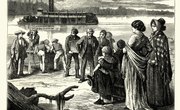During the Great Depression, the American government forcibly deported between 1 and 2 million American citizens and legal residents of Mexican descent. This mass deportation, known as the Mexican Repatriation, took place from 1929 to 1939 and was fueled by panic over unemployment in the United States. Although the repatriation changed the lives of millions, historians have only recently began to study and understand what happened.
The Early 1900s
In the early 20th century, several factors led to increased immigration from Mexico. The violence of the Mexican Revolution and the American demand for labor made the United States an appealing option for many who wanted safety and stability for their families. Legal immigration was easy at the time, with no quotas or restrictions on immigrants from Mexico and an inexpensive and quick visa process at the border. By 1930, the population of Mexican Americans had grown to almost 1.5 million. Over half of these people were born in the United States.
The Stock Market Crash
The stock market crash of 1929 signaled the onset of the Great Depression, a time of economic devastation and extremely high unemployment. As many Americans panicked, they began to blame immigrants for their problems. As a result, people of Mexican descent were systematically denied jobs, subjected to raids and illegally detained without warrants. In 1931, federal and state governments began to support a process of instructing social workers to encourage Mexican Americans to leave. Torture, illegal imprisonment and other methods of coercion were also used. The government began to send trains with thousands of people of Mexican descent to Mexico. Many of these were American citizens who did not speak Spanish.
Repatriation
When the repatriated Mexican Americans arrived in Mexico, some were able to locate family members to live with, but many others had nowhere to go. The Mexican economy was not prepared to accommodate the new influx of people, and although it attempted to create agricultural colonies for the repatriated, starvation and disease resulted in dozens of deaths, permanently ending the project. The citizens of Mexico also did not welcome the new arrivals, resenting that they had left during the revolution and the burden that their presence created.
Results
As a result of the repatriation, families were forced to transition from comfortable lifestyles in the United States to conditions of extreme poverty. Lack of housing, plumbing, food and access to education created hardships for many when they arrived in Mexico. Returning to the United States also proved to be a serious problem. Historians estimate that at least 60 percent of the repatriated Mexican Americans were citizens of the United States; however, unless individuals were able to produce papers proving their nationality, they were not readmitted. Because it was impossible for many to access their documents, many citizens were never able to return to the U.S.
Related Articles
References
Writer Bio
Agatha Clark is from Portland, Ore., and has been writing about culture since 2001. She specializes in intercultural communication and is completing a Bachelor Arts at the University of Oregon with double majors in linguistics and Spanish. Clark is fascinated by expressions of human psychology and culture. Before refocusing her educational path toward language, she originally went to school to become an artist.











